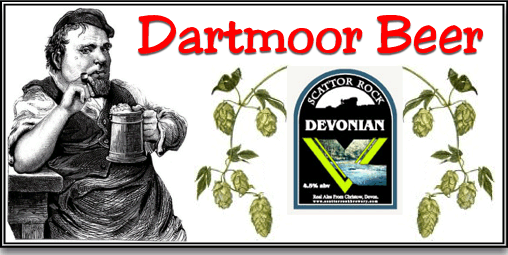
It seems a fair assumption that with all the cider drunk in Devonshire beer consumption would be lower than other areas but this was not so. Old farm inventories for Devon show that there were 30 references to cider but 68 to beer and beer making. It must be remembered that at one time the only way of preserving food was by ‘salting’ and much of the butter and cheese was heavily seasoned with salt which meant people were continually thirsty. The only available drinks to the average person was dubious water, beer or cider, in the early days tea was a luxury affordable only by the rich.
In the case of beer, some farms had ‘brew houses’ and ‘malt houses’ which contained the coppers and dryes. The brewing process entailed firstly obtaining the malt, this came from sprouting grain such as wheat, rye, oats and in some cases barley. The grain would be spread on a flat cloth made of hair known as the ‘haire drye’ and a straw fire lit beneath it and this ‘raising of malt’ was usually the task of the wife. Once the grain had been malted it would then be ‘brewed’ in the copper.
In the 15th century a well known Devonshire brew was the ‘oaten beer’ of which John Hooker wrote, Stanes, 2005, p.54:
“… yet in the north part thereof about Okehampton…, the oats which they sow be all spoiled oats and the drink which they do make thereof is spoiled drink for it be never so well prepared and dressed, yet what creature so ever do eat or taste thereof, be it man horse or hogge, it will make him to vomit and, for the time, very sick: notwithstanding the of that country, being used thereat, do endure the same very well.”
Another commentator described oaten ale to “wash that pigs had wrestled dryn!” Finberg, 1969, p.100 notes how in the 15th century the farm labourers received at Christmas and Easter an allowance of braseum capitale or prime brew made from wheat-malt. This was in contrast to their usual brew of braseum cursale or common brew made from oats. Finberg, p96 also remarks how from 1460 onwards the large ‘black oat’ was malted to provide ale for the Abbey’s harvesters.
By the 17th century the addition of hops to the brew was seen in some places which greatly enhanced the ale’s taste. Hop yards were a common occurrence in some of the warmer parts of lowland Devon by the 18th century.
Today there are two breweries on Dartmoor, the first one is at the back of the Prince of Wales pub in Princetown and the other is at Christow. The Scattor Rock brewery at Christow was established in 1998. They produce 4 session beers which range from 4 – 5% abv and a range of 17 ‘Tor Beers’ which range from 3.8 – 5% abv. Over the 7 years of brewing there have been 18 seasonal and occasional brews which have ranged from 3.8 – a mind numbing 8% abv, one such seasonal beer is the Christmas brew called ‘Scattor Clause’.
![]()
The other brewery is the Princetown Breweries which as previously stated was located at the back of the Prince of Wales pub in Princetown. This brewery was established in 1994, by 1998 it was producing 60 barrels of beer a week and supplying over 20 local pubs with ‘Jail Ale’ and Dartmoor IPA. A £1 million building was built in 2005 with production at around 30 barrels as day but with scope for 60 barrels. This is reputed to be the highest brewery in England and stands at an altitude of about 1,300 ft. At the end of 2005 the brewery moved to its new site in Station Road in Princetown and the brewing capacity is now up to 150 brewers barrels (720 nine gallon casks) a week. The two main brands are still Jail ale which has a strength of 4.8% ABV and Dartmoor IPA at 4.0% ABV.
Bibliography.
Finberg, H.P.R. 1969 Tavistock Abbey, David & Charles, Newton Abbot.
Stanes, R. 2005 Old Farming Days, Halsgrove Publishing, Tiverton.
 Legendary Dartmoor The many aspects past and present of Dartmoor
Legendary Dartmoor The many aspects past and present of Dartmoor
